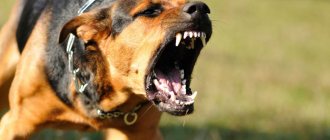During the first 24 hours after the birth of puppies, the dog often experiences rapid breathing, which is caused by fatigue, mild hyperthermia, or increased hormone production due to mechanical stimulation of the nipples during feeding. Shortness of breath in a dog after birth is considered a pathology when its intensity does not decrease on the second day after delivery. In this case, you need to contact a veterinarian to identify the causes and provide adequate treatment.
Signs
Normally, a dog’s respiratory rate is 10–30 times per minute (the smaller the animal, the higher this figure). More frequent breathing in a dog after childbirth is caused by respiratory failure, which is manifested by the following signs:
- noticeable effort when performing the inhalation-exhalation cycle;
- the presence of wheezing, whistling or other uncharacteristic sounds;
- replacing nasal breathing with oral breathing;
- frequent changes from an excited state to a depressed state and vice versa;
- unusual posture (elongated neck, widely spaced front paws, inability to lie down for a long time);
- pallor or bluish tint of lips.
It is important to know that in dogs, external changes in the respiratory process are symptoms of dysfunction not only of the respiratory system, but also of the circulatory system. Therefore, failure of breathing always increases the load on the heart muscle, which significantly worsens the general condition of the animal.
Why the dog shakes: psychological reasons
With physiological manifestations, tremor in dogs is not dangerous. It disappears along with the departure of the source of irritation.
Stress factors
The dog is trembling under the influence of strong emotions:
They promote the production of adrenaline and cortisone, substances related to stress hormones. Under their influence, metabolic processes accelerate, the heart contracts faster, and the nervous system is activated. Excessive amounts of hormones enter the muscles and the body gets rid of them through contractions of muscle tissue.
Important! If there are regular attempts to hide or unpredictable behavior on the street, or when seeing cars, the animal must be shown to a veterinarian.
The state of chronic stress is a dangerous phenomenon that leads to lethargy, drowsiness, and increased blood pressure. Under its influence, the functioning of the immune system is disrupted, blood glucose levels increase, and skin diseases develop.
Stress and anxiety
Trembling may appear when the owner returns home, in anticipation of a walk or treat, before a haircut, or when trying to attract attention. In this case, it is compared to involuntary wagging of the tail (the whole body) - a feature found in emotional pets or in those who have it docked.
Defensive reaction
Shakes the dog both during hypothermia and overheating. Sometimes the phenomenon occurs as a defensive reaction to pain, an unfamiliar place. Some animals express dissatisfaction in this way when traveling to a veterinary hospital.
Emotions: excitement, worry, fear
Unreasonable trembling practically does not occur; it is accompanied by certain factors:
- Stressed - the terrier tries to hide before being scolded or after being punished for mischief.
- Fear is a sharp sound, noise, or the appearance of a source of potential danger.
- Joy is excitement or anticipation of something pleasant.
Important! In Dachshund and Yorkie puppies, the phenomenon is associated with peculiarities of the psychological state or cunning.
In this case, the pet may squeal, flinch, or hunch over.
Causes
The causes of shortness of breath in a dog after childbirth can be both specific and general. Specific disorders include disorders that arise as a result of pregnancy and childbirth. Common causes, in turn, are divided into 3 groups:
- respiratory – diseases or mechanical damage to the respiratory system, the presence of tumors or fluid accumulation in the sternum;
- cardiac – weak heart or poor circulation;
- neurological – postpartum stress, pain shock, central nervous system pathologies, brain tumors, head injuries.
In any case, rapid breathing in a dog after childbirth is only an external sign of pathological processes occurring in the body. The most common reasons why a dog may experience shortness of breath are:
- fear, stress;
- high body temperature;
- exacerbation (during childbirth) of diseases of the bronchopulmonary or vascular-cardiac system;
- infectious diseases.
Also, the cause of rapid breathing can be disturbances in the birth process, as a result of which unborn puppies or retained placenta remain in the womb. In nursing dogs, shortness of breath can be caused by eclampsia. This pathology is accompanied by a sharp decrease in glucose and calcium levels, which leads to the development of milk fever with convulsions and the risk of asphyxia (suffocation).
A particular danger to the health and life of a dog is shortness of breath, which appears against the background of general weakness, vomiting, bleeding, anemia and other clinical signs. In all of these cases, urgent medical attention is required, since there is a high probability of death.
Eclampsia in dogs after birth
Eclampsia is an acute postpartum disease in which a sharp decrease in the content of ionized and total calcium in the blood causes an imbalance of minerals. It's called "milk fever."
Characteristic symptoms:
- Nervousness, anxiety, increased excitability and activity.
- Loss of coordination of movements (ataxia), tetany (muscle spasms), convulsions.
- Vomit.
- Acceleration of pulse, breathing, increase in temperature to 40-41 degrees due to dysfunction of the central nervous system.
Consequences of eclampsia: cerebral edema, cerebral hemorrhage, asphyxia, pulmonary edema, pneumonia, death. The cause of eclampsia can be called insufficient okolosvetovyh glands to instantly regulate the balance of calcium, when the body needs it in significant quantities (for the formation of the bone apparatus of puppies of the milk generation).
If your loved one is expecting a large litter and she is small in size, for example if you have a Chihuahua, then you can't relax, signs of eclampsia can occur even hours before delivery. Often the disease occurs after 3 days after birth, and after 2-4 weeks of lactation (puppies then consume the maximum amount of milk). A woman needs to watch until the end of lactation. Remember! If severe signs appear, provide first aid, otherwise the dog may die. Warm the animal, wrapped in a blanket and sitting up, filled with hot water bottle. Inject intramuscular PET with 10 ml of 10% calcium gluconate solution or the same dose of calcium borogluconate solution (10-20% strength). Introduce the dose slowly; this is a painful process for the animal. An alternative way to administer calcium chloride is to dilute 10 ml with milk and pour it into the mouth. Calcium chloride cannot be injected as it can cause tissue necrosis.
The next phase of resuscitation is intramuscular sulfocamphocaine (from Cordiamine) in an amount of 1 ml. This will help stimulate the vasomotor and respiratory centers, prostimulirujte the central nervous system. Instead, you can leave 5 drops of Corvalol, Valerian or on your tongue. To maintain cardiac activity, magnesium sulfate can be administered intramuscularly.
The next step is to give a diphenhydramine tablet (inject 1 ml of diphenhydramine intramuscularly).
Ask your veterinarian in advance for the exact dosage your pet needs for these medications. Please be on time for drugs - after birth, you will receive timely medical care, this will increase the chances of maintaining health.
First aid
The main thing you should not do is self-medicate and delay contacting a veterinarian. You can only provide first aid to your pet before the veterinarian arrives.
Important! Shortness of breath after childbirth causes deep stress in the dog, as it provokes an abnormal heart rhythm, which leads the nervous system into an excited state. Therefore, you should not force the animal down or force it to drink and eat, so as not to aggravate the situation.
In addition, if the lungs are oversaturated with oxygen in a pet in a supine position, the lung tissues can rupture. It is better not to touch her or move her to a quiet place and calm her down by stroking her chest.
In general, the first aid algorithm for a dog with difficulty breathing should be as follows:
- rub any decongestant drug under the tongue - ½ tablet for every 7 kg of dog weight;
- intensively rub your back, chest and ears, perform a closed heart massage;
- Inject the immunostimulant intramuscularly, dividing the dose required according to the instructions by 4 and giving an injection into each paw;
- slowly inject potassium chloride into a vein from 3 to 15 ml, depending on the size of the pet.
All of these activities are carried out after calling a veterinarian to your home or while waiting for the opportunity to deliver the animal to the clinic.
Symptoms of rapid breathing and heartbeat
With rapid breathing caused by malaise, changes in the animal's behavior are immediately noticeable. It can be:
- restless behavior, trembling;
- cough, shortness of breath, hoarseness;
- blue gums;
- reluctance to eat;
- vomiting, diarrhea.
Moreover, if the dog has rapid breathing and heartbeat, as well as trembling, it is almost impossible not to see all this. When a pet exhibits disorientation, it is most likely to suffer from heatstroke. He should be placed in a cool place, given a drink, and a wet towel applied to his head.
A bluish tint to the tongue and fainting can occur with heart problems. In this case, the animal should be well covered, warm heating pads should be applied to its paws, a veterinarian should be called to the house, and before his arrival, Cordiamine should be administered intramuscularly. But the presence of a whole set of the above symptoms should be a particular cause for concern. In this case, a visit to an experienced veterinarian is mandatory, because this is exactly the case when, as they say, delay is like death.
When is a visit to the vet necessary?
A visit to a canine doctor is required for animals with the following clinical signs:
When visiting the clinic, your pet will undergo a full examination and diagnostic examination, which will help to understand the cause of the deviation. Identifying diseases at the primary stages of development gives a better chance of recovery. Ignoring obvious symptoms will lead to the pathology becoming chronic, and in worst cases, to the death of the animal.
It is impossible to accurately determine the source of muscle contractions in a pet without diagnostics - the doctor is based not only on visual examination data, but also on the results of laboratory tests. Many owners make the mistake of mistaking pathology for physiological manifestations, wasting precious minutes.
Heart failure
Listed above are all the main possible reasons when a dog is breathing frequently. But the most common disease is this. Let’s talk about it in more detail. All heart diseases can be divided into three groups:
- congenital;
- acquired;
- age.
Congenital defects are more common in young pets. Very often in this case, animals die, since the body is still quite weak. Acquired defects, as a rule, occur in middle-aged animals, and age-related defects occur in animals older than eight years. In addition to rapid breathing, heart disease may cause other symptoms in pets.
Small dogs stop playing, sleep longer, and do not gain weight at all due to the fact that they do not eat well.
Adults may experience shortness of breath even at rest. The dog is very lethargic and may faint during a quiet walk. There is a possibility of rapid weight gain due to high water consumption.
All of these symptoms are causes of heart problems in your pet. This can also include unsteady gait, weakness, and refusal to eat.
If it is a sign of heart disease, you should switch your pet to feeding in small portions, and also reduce the amount of physical activity and walks. The doctor must prescribe special medications. They should be taken exactly as directed.
Dancing Doberman disease
This neurological syndrome is characterized by flexion of one hind limb while standing. Over time, the second hind limb is affected. A sick dog bends and extends its limbs alternately, as if in a dance. It is assumed that there is a combined response to a sensory stimulus and an automatic neurological impulse. The disease occurs in Doberman Pinschers between 6 months and 7 years of age and affects both males and females. September 14, 2012
Symptoms and types
The main symptom is the bent position of one paw while standing. The second limb is usually affected after 3-6 months. When a dog changes its paws, it appears as if it is dancing. The animal cannot control it. Soon after the onset of the disease, these overactive tendon reflexes lead to progressive muscle atrophy of the limbs. Sometimes the muscles of the limbs lose the ability to respond to the dog's desire to move. This is called proprioceptive deficit.
Causes
The cause of this disease is unknown, but it is believed to be inherited recessively.
Diagnostics
Other conditions associated with Dancing Doberman disease may include lumbosacral stenosis (a narrowing of the lower part of the spinal canal that compresses the nerve roots) or an infection of one or more bones in the spine or the intervertebral discs that connect them in the lumbar region (intervertebral disc disease and discospondylitis, respectively). Dancing Doberman disease is usually painful. A veterinarian can also diagnose cancer of the lumbar spinal cord or nerve endings. This condition progresses quickly and can be painful.
What to do if your dog is breathing heavily?
Stress is one of the pathological causes of trembling. With it, the dog cannot cope with its emotions for a long time, which is why it shakes violently for quite a long time.
Tachypnea (rapid breathing) can be caused by being in a tight confined space when the dog does not have enough air. Shortness of breath may occur from fright or overexcitement, especially in puppies and small breeds (Yorkies, Pomeranians, Chihuahuas, etc.).
Therefore, after vaccination, you need to stay in the veterinary clinic for about 30 minutes.
But all these phenomena are normal. But if the dog is breathing frequently and at the same time her breathing is rapid, and she herself is not very active or is generally absolutely calm, there may be problems. Just watch your pet. When a dog is healthy in a calm environment, it does not open its mouth when it breathes and does not make any sounds when breathing (this is, of course, unless it has a special muzzle structure, such as pugs, which can not only snore, but also snore).
And what should come after?
After the third stage of labor - the departure of the placenta - begins, which begins after the expulsion of all placenta and lasts until the uterus and other genital organs of the female are completely restored.
An alarm signal during this period
are bleeding for more than 3 weeks, depressed state,
A change in temperature in dogs is the main indicator of well-being, indicating that something is wrong with the pet. Normal temperatures vary slightly between breeds. The indicators are individual for each dog, so measurements are taken regularly. In an adult dog, the temperature ranges from 37.5° to 38.5°. The normal temperature of puppies is 39°. Breed also affects body temperature: the larger the animal, the “colder-blooded” it is. If the normal body temperature of a small breed dog in normal condition is 38.5-39°, in large breeds it is higher – 37.4-38.3°.
It happens that owners are worried about their pet’s high temperature. Start with a complete examination of the dog, determine if the behavior is different from normal. The human body regulates temperature through sweating, quickly cooling the body. Dogs do not sweat; sweat glands are present in several breeds. When cooling down, pets stick out their tongues and begin to breathe quickly.
Changes before childbirth
After mating a bitch, the owners eagerly await the first signs of pregnancy of their pet. On the 22nd day it is already possible to carry out ultrasound diagnostics
and make sure that it has arrived. On average, the duration of pregnancy in female dogs ranges from 57 to 69 days after fertilization.
Maintaining a schedule
Experts recommend prophylactically measuring the temperature of a pregnant bitch at least once a week.
, even if nothing bothers you. Needless to say, if something bothers you in her behavior, you should immediately consult a doctor.
Attention!
And when, according to the owners’ calculations, there is about a week left before the birth, in the morning and evening it is necessary to enter the measurement results into a graph or table in order not to miss the moment when it sharply drops by 1-2 degrees. It is believed that labor will occur within the next 24 hours.
This will allow the owner to be free from other matters in order to... Sometimes a doctor or a dog breeder experienced in this matter is immediately called to attend the birth.
Physiological features of toy terriers
The Toy Terrier is a small (also called “pocket”) dog, with an average height of 20-30 cm and an average weight of 1.5 to 3 kg.
live from 12 to 15 years . These pets are thin-boned, with high legs, square in shape with angular muscles. A wedge-shaped head, a rounded skull and a convex wide forehead are also characteristic features of the breed.
Read more about what Toy Terriers look like here.
To establish proper dog breathing, the transverse cartilaginous half-rings of the trachea provide the necessary rigidity so that the trachea does not collapse during inhalation, and the softer parts ensure its plasticity.
Treatment and emergency care - what to do in case of respiratory failure?
Veterinary care for an animal leads to an exacerbation of the stressful condition, which complicates the pathology. Therefore, in some cases (threatening the dog’s life), additional diagnostic procedures should be abandoned until the animal’s condition normalizes. It is better to use narcotic and sedatives to facilitate the examination and treatment of your pet.
Emergency help if your dog is choking:
- examination of the upper respiratory tract and removal of foreign bodies;
- artificial ventilation (oxygen masks, bags);
- tracheotomy (for fractures of the nasal bones, collapse of the larynx;
- intravenous oxygen administration.
After eliminating the threat to the patient’s life, additional diagnostic procedures are performed - radiography, ultrasound. Determining the cause of difficulty breathing will allow you to choose the right treatment aimed at stopping the etiological factor.
If a dog is suffocating due to blockage of the upper respiratory tract, it is necessary to urgently remove bodies and damaged tissues and restore normal respiratory activity. Otherwise, intubation is performed. Intravenous administration of dexamethasone at a dose of 0.5 mg/kg or similar corticosteroids has a good positive effect. Be sure to monitor the dog's temperature - hyperthermia leads to increased breathing, so antipyretic drugs and cold compresses are used.
Treatment of pulmonary edema is aimed at restoring cardiovascular activity and removing excess fluid. Dogs are prescribed furosemide or other diuretics. Means for dilating blood vessels allow you to normalize the functioning of the heart - use nitroglycerin. Be sure to support the work of the heart muscle with dobutamine or analogues.
In case of bronchopneumonia, it is necessary to eliminate the exudate accumulating in the bronchi and alveoli. To do this, a general course of antibiotics is administered to suppress pathogenic microflora. Improve ventilation of the lungs with the help of bronchodilators.
Mucaltin and bromhexine are used as expectorants. General compensatory therapy is carried out - intravenous injections of plasma substitutes, saline solution, glucose.
[custom_ads_shortcode2]
How to measure a dog's temperature?
To carry out measurements, you must use a medical thermometer: mercury or electronic. The second option is considered safer, more convenient and you will have to wait no more than a minute for measurements. It is better to learn from an early age what temperature is considered normal in dogs, and the pet itself should be accustomed to the procedure in order to avoid aggressive behavior in the future. A separate thermometer must be allocated for the animal. There are instructions for doing it at home:
- Take a clean thermometer and disinfect it. Lubricate the tip with baby cream or Vaseline. If the dog is obedient, then it can stand, and if not, then lay it on its side. It is important that she is calm, otherwise nothing will work out.
- Lift your tail and insert the thermometer into the anus approximately 1.5-2 cm using rotational movements, no deeper is needed. If the measurement is carried out in a standing position, then to prevent her from sitting down, hold her firmly by the root of her tail.
- During the procedure, praise and talk to your pet to calm him down. After the sound signal, it is recommended to wait another half a minute, and then you can remove the thermometer. Don't forget to praise and give treats.
How to determine a dog's temperature without a thermometer?
There are several ways to understand that an animal has a fever, but it is important to note that they are not reliable, but only provide a basis for further diagnosis.
- There is increased blood flow on the paws and ears, so when the temperature increases, these parts of the body become hot to the touch. You need to touch them either with the back of your hand or with your cheek.
- When figuring out how to determine a dog’s temperature, it’s worth remembering another way - feeling the groin area and armpits. Here are the lymph nodes, which increase in size if there is an infection or disease in the body. Temperatures are also increasing in these places.
- Many, even children, know that the condition of an animal can be determined by its nose; if it becomes hot, it means there are problems.
- Experts recommend looking into your pet’s mouth and assessing the condition of the gums. If everything is normal, they will be pink and moist. Any changes can be considered a signal of problems.
A successful birth of a dog is a joy for both the new mother and the owner who watches the touching squeaking puppies. Unfortunately, the birth of cubs does not always end happily: childbirth in dogs can lead to the development of complications, many of which are very dangerous for the health of both the female herself and all her offspring.
In general, in cases where the dog gave birth quickly, without experiencing any difficulties, no complications should be expected, since the prerequisites for their development are simply absent. If your pet feeds the puppies, cares for them, and the babies do not show any signs of anxiety, then everything is probably fine. Moreover, many manifestations of “diseases”, as they are perceived by inexperienced breeders, upon closer examination do not indicate anything serious.
Of course, you shouldn’t “relax” completely, since some types of postpartum complications can appear several days or even weeks after birth. Some of them (eclampsia, for example) can develop within a couple of hours, and if help is not provided, the case will most likely end in death. To avoid such sad consequences, we advise you to make it a rule to watch your pet and puppies for at least an hour a day.
First, we will discuss signs that are equally likely to indicate some complications or be the norm. But how can one distinguish pathology from physiological phenomena characteristic of the body of a recently given birth dog? The answer is simple - if you categorically do not like something in the behavior or appearance, immediately call the veterinarian.
In any case, a preventative examination by a specialist will not hurt an animal during the postpartum period.
Shortness of breath in puppies
The owners of the puppies closely monitor them. Due to inexperience in cynology, the baby’s behavior provokes the owner to worry and can cause confusion because the puppy is breathing frequently. The cause of a puppy's rapid breathing can be overwhelming emotions or overexcitement. It is not uncommon to see your puppy breathing rapidly while sleeping. In most cases, this is a normal physiological state of the baby.
. If he behaves cheerfully, cheerfully and has a good appetite, then there is no need to worry about resorting to a full diagnosis.











